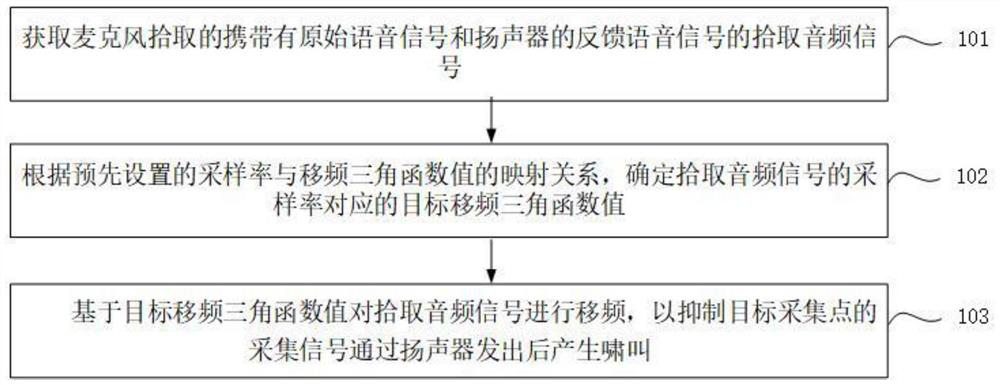Howling suppression method and device thereof, electronic equipment and storage medium
A technology with a preset fixed sampling rate, applied in the field of electronic equipment, storage media, devices, and howling suppression methods, can solve the problems of consuming large computing resources, dragging down the audio system signal conversion process, and reducing the real-time performance of the audio system, etc., to achieve The effect of increasing speed
- Summary
- Abstract
- Description
- Claims
- Application Information
AI Technical Summary
Problems solved by technology
Method used
Image
Examples
Embodiment 1
[0027] figure 1 It is a schematic flow chart of the howling suppression method provided in Embodiment 1 of the present application. This embodiment is applicable to the scene where the howling phenomenon of the loudspeaker is suppressed in the audio system. The method can be executed by a howling suppression device, which can It is realized by means of hardware and / or software, and generally can be integrated in electronic devices such as computers with data computing capabilities, specifically including the following steps:
[0028] Step 101. Acquire a picked-up audio signal picked up by a microphone and carrying an original voice signal and a feedback voice signal of a speaker.
[0029] In this step, the picked-up audio signal picked up by the microphone will include the original voice signal and the feedback voice signal fed back to the microphone by the speaker, wherein the original voice signal is the signal to be amplified, such as human voice, music, etc. The signal pl...
Embodiment 2
[0051] see image 3 , image 3 It is a schematic flowchart of a preset mapping relationship between a sampling rate and a frequency-shifting trigonometric function value provided by Embodiment 2 of the present application.
[0052] Such as image 3 As shown, in this embodiment, the process of presetting the mapping relationship between the sampling rate and the frequency shift trigonometric function value may include:
[0053] Step 301. For different sampling rates, use a preset first formula to determine the frequency shift trigonometric function value corresponding to each sampling rate.
[0054] Step 302, for any sampling rate, map the sampling rate and the corresponding frequency shift trigonometric function value, and store in the form of a mapping relationship.
[0055] It should be noted that the preset first formula in this embodiment is:
[0056] cos(θ)=cos(2*π*n*(Δf 0 / n) / fs), sin(θ)=sin(2*π*n*(Δf 0 / n) / fs);
[0057] Among them, n is the acquisition order, Δf ...
Embodiment 3
[0061] Figure 4 It is a schematic structural diagram of a howling suppression device provided in Embodiment 3 of the present application. The howling suppression device provided in the embodiment of the present application can execute the howling suppression method provided in any embodiment of the present application, and has corresponding functional modules and beneficial effects for executing the method. The device can be implemented in software and / or hardware, such as Figure 4 As shown, the howling suppression device specifically includes: an acquisition module 401 , a determination module 402 , and a frequency shift module 403 .
[0062] Wherein, the obtaining module is used to obtain the picked-up audio signal that carries the original voice signal and the feedback voice signal of the loudspeaker picked up by the microphone;
[0063] A determination module, configured to determine a target frequency-shifting trigonometric function value corresponding to the sampling...
PUM
 Login to View More
Login to View More Abstract
Description
Claims
Application Information
 Login to View More
Login to View More - Generate Ideas
- Intellectual Property
- Life Sciences
- Materials
- Tech Scout
- Unparalleled Data Quality
- Higher Quality Content
- 60% Fewer Hallucinations
Browse by: Latest US Patents, China's latest patents, Technical Efficacy Thesaurus, Application Domain, Technology Topic, Popular Technical Reports.
© 2025 PatSnap. All rights reserved.Legal|Privacy policy|Modern Slavery Act Transparency Statement|Sitemap|About US| Contact US: help@patsnap.com



